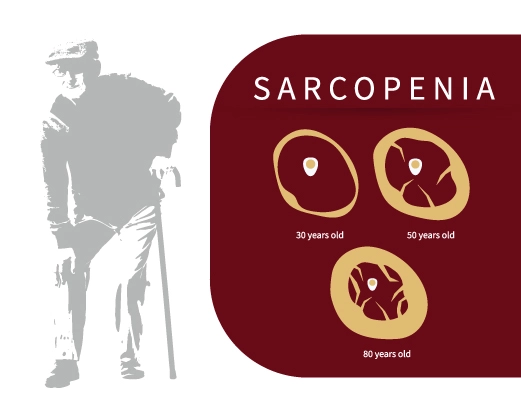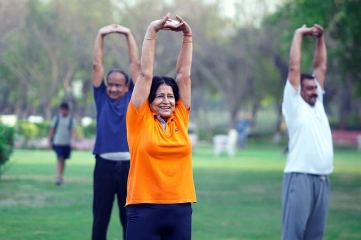Physical Exercise
- Aerobic Exercise
- Resistance Exercise
40%-70%
Primary symptom
Sarcopenia is a syndrome characterized by the progressive and generalized loss of skeletal muscle mass and strength. It increases the risk of adverse outcomes such as frailty, falls, fractures, physical disability, poor quality of life, and even mortality. The primary symptom is muscle weakness.
Sarcopenia is a common complication in patients with liver cirrhosis, with a prevalence ranging from 40% to 70%. It significantly impacts patient outcomes both before and after liver transplantation. The condition is multifactorial in origin, caused by an imbalance between protein synthesis and protein breakdown.
Reference: J Gastroenterol. 2019 Oct;54(10):845-859

Clinical guidelines recommend combining moderate physical exercise with adequate protein and energy intake to help
restore muscle mass and function



Liver cirrhosis is a major public health concern in India due to its high frequency and severe complications. In 2015, India accounted for 18.3% of the two million global liver disease-related deaths, highlighting the alarming burden of liver disease in the country.
Mortality due to chronic liver diseases (CLDs), including cirrhosis and its complications, is progressively increasing.
These risk factors are growing due to changing lifestyles and social habits, making NAFLD and ALD particularly concerning. In total, CLDs accounted for 2.1% of all deaths in India.




 Myth
MythSarcopenia in liver cirrhosis is a rare condition.

 Fact
FactSarcopenia in liver cirrhosis is a common complication, affecting up to 70% of patients with live cirrhosis.
 Myth
MythSarcopenia in liver cirrhosis only affects people with advanced disease

 Fact
FactSarcopenia in liver cirrhosis only affects people with advanced disease
 Myth
MythSarcopenia in liver cirrhosis is only caused by malnutrition

 Fact
FactWhile malnutrition is a common contributor to sarcopenia in liver cirrhosis, other factors such as physical inactivity, hormonal imbalances, and inflammation also leads to muscle loss and frailty
 Myth
MythSarcopenia in liver cirrhosis is irreversible

 Fact
FactSarcopenia in liver cirrhosis can be reversed with a combination of nutritional support, physical exercise, and pharmacological interventions
 Myth
MythLiver transplant is the only treatment for sarcopenia in liver cirrhosis

 Fact
FactWhile liver transplant may improve or reverse sarcopenia in some cases, other treatments such as nutritional support, exercise, and medications can also be effective
 Myth
MythSarcopenia in liver cirrhosis is not a serious condition

 Fact
FactSarcopenia in liver cirrhosis is associated with an increased risk of complications, including malnutrition, infections, hepatic encephalopathy, and hepatorenal syndrome (HRS), and can negatively impact quality of life and also lead to early mortality.
 Myth
MythSarcopenia only affects older adults

 Fact
FactSarcopenia is more prevalent in older adults, but it can affect people with all ages
 Myth
MythSarcopenia is only caused by ageing

 Fact
FactSarcopenia is significantly caused by ageing, but other factors such as physical inactivity, poor nutrition, chronic diseases such as chronic liver disease, alcoholic liver disease contribute to the development of sarcopenia
 Myth
MythSarcopenia cannot be prevented or treated

 Fact
FactSarcopenia can be prevented and treated through lifestyle changes such as proper nutrition support. Exercise, aerobic exercise, as well as medical interventions.
 Myth
MythStrength training is the only way to prevent or treat sarcopenia

 Fact
FactNutritional intervention is an essential component with strength training Exercise has an impact on both cardiovascular fitness and increasing muscle mass and promoting muscle protein synthesis
 Disclaimer
DisclaimerProNocte is a health supplement and is not intended to diagnose, treat, cure, or prevent any disease.